Transform Your Space with Large Indoor Plants
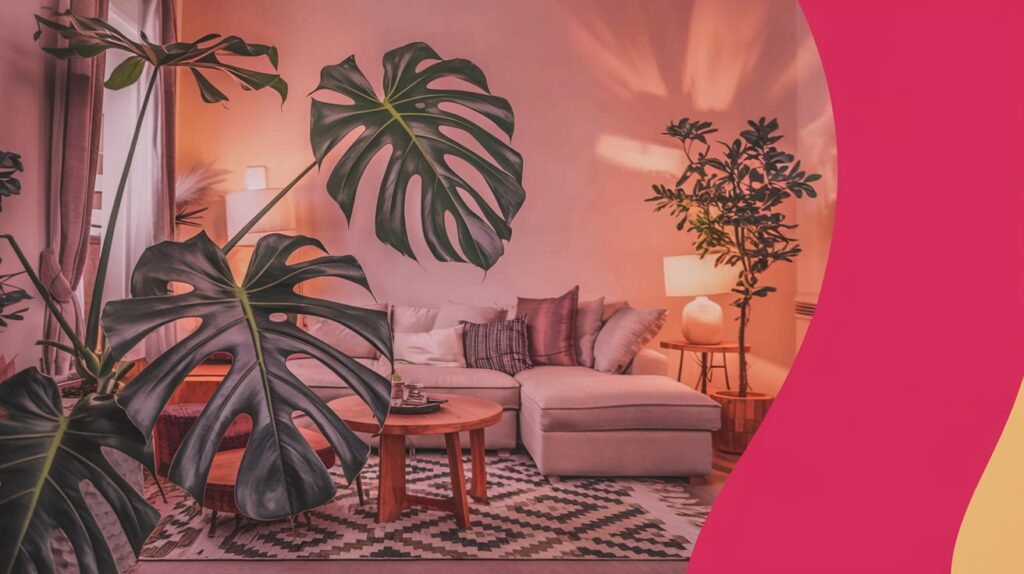
Imagine walking into a room filled with lush, towering greenery that instantly uplifts your mood and enhances your living space. The magic of large indoor plants transforms an ordinary room into a vibrant, natural sanctuary. Incorporating large indoor plants into home decor is more than just a trend—it’s a lifestyle choice. More and more people are embracing the beauty and benefits of indoor greenery, from modern apartments to spacious homes. These plants not only add life to any room but also bring with them numerous advantages, making them a popular choice for decor enthusiasts.
The benefits of large indoor plants extend beyond aesthetics. These plants improve air quality, provide a calming ambiance, and offer functional uses like natural room dividers. With just a few carefully selected plants, you can dramatically change the atmosphere of your living space.
Benefits of Large Indoor Plants
Aesthetic Appeal
Large indoor plants make a bold statement in any room, often serving as focal points that enhance the overall interior design. Whether you’re aiming for a minimalist, boho, or modern style, the right plant can tie the room together effortlessly. Some of the most popular choices include the Monstera Deliciosa, known for its unique leaf patterns, and the Fiddle Leaf Fig, which adds an elegant, sculptural quality to any space.
Examples of Popular Large Indoor Plants:
- Monstera Deliciosa: Eye-catching with its split leaves.
- Fiddle Leaf Fig: Perfect for contemporary and mid-century modern designs.
- Bird of Paradise: Brings a tropical, exotic feel to your home.
Health Benefits
Large indoor plants aren’t just for looks—they also significantly improve the air quality in your home by filtering out toxins. Plants like the Rubber Plant and Majesty Palm are excellent at removing pollutants from the air, promoting a cleaner, healthier environment. Additionally, studies have shown that being around plants can reduce stress, improve concentration, and elevate your overall mood.
Key Benefits:
- Natural air purifiers.
- Stress reduction and mood enhancement.
Functional Uses
Beyond aesthetics and health, large indoor plants can serve functional purposes in your home. For instance, tall plants like the Bird of Paradise or Majesty Palm can act as natural room dividers, adding a soft partition between different areas. These plants can also absorb sound, making them useful for reducing noise in open spaces or busy households. Whether you need more privacy or wish to define separate living areas, large plants provide a natural, eco-friendly solution.
Functional Ideas:
- Use plants to create privacy screens.
- Reduce noise levels in large, open-plan spaces.
Top Large Indoor Plants to Consider Monstera Deliciosa (Swiss Cheese Plant)
The Monstera Deliciosa, often called the “Swiss Cheese Plant,” is famous for its large, fenestrated leaves. Its exotic look makes it perfect for adding a tropical vibe to your home. This plant thrives in bright, indirect light and requires regular watering but prefers to dry out between waterings.
Care Tips:
- Ensure that you remain in well-illuminated spaces while steering clear of direct sunlight.
- Water when the top inch of soil feels dry.
Fiddle Leaf Fig
The Fiddle Leaf Fig is a highly sought-after plant for its large, glossy leaves that add dramatic flair to any room. However, it can be temperamental if not cared for properly. It prefers bright, indirect light and should be watered only when the soil is slightly dry. Ensure it is placed away from cold drafts and extreme heat.
Common Issues: Yellowing leaves or dropping foliage often indicate overwatering or poor lighting conditions.
Bird of Paradise
With its large, paddle-shaped leaves and exotic flowers, the Bird of Paradise adds a tropical charm to any home. While it’s primarily admired for its lush green foliage indoors, it can flower when given proper care. This plant prefers bright, direct sunlight and requires consistent watering during warmer months, while less water is needed during winter.
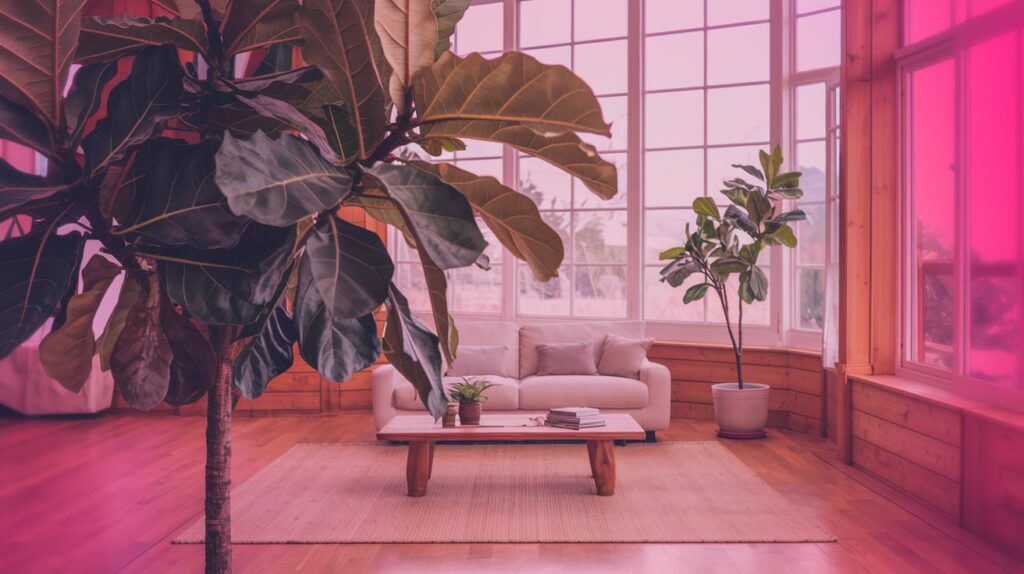
Best Practices:
- Ensure plenty of sunlight.
- Mist regularly to mimic its tropical environment.
Rubber Plant
The Rubber Plant is another fantastic option for those seeking a statement piece. Known for its thick, glossy leaves, this plant is both visually appealing and effective at purifying the air. It thrives in medium to bright indirect light and enjoys a well-draining soil mix.
Care Tips:
- Water once the soil is dry to the touch.
- Wipe the leaves regularly to keep them dust-free and shiny.
Majesty Palm
The Majesty Palm brings a sense of grandeur to any indoor space. With its arching fronds, it instantly adds a luxurious feel to your home. This palm enjoys bright, indirect light and slightly moist soil, making it an ideal plant for living rooms or large entryways.
Placement Ideas:
- Ideal for occupying vacant corners or enhancing the vertical dimension of a room.
- Pair with woven baskets for a boho-inspired look.
How to Care and Styling Tips
Large indoor plants can transform any space into a lush, vibrant environment, but they also require proper care to thrive. From understanding their light needs to choosing the right pots, here’s a guide on how to keep your large indoor plants healthy and beautifully integrated into your home decor.
How to Care for Large Indoor Plants
Light Requirements
Understanding Light Needs: Different large indoor plants have varying light requirements. While some plants, like the Bird of Paradise, thrive in bright, direct sunlight, others, such as the Fiddle Leaf Fig, prefer bright but indirect light. It’s essential to assess the natural light in your home and choose plants that match these conditions.
Tips for Adequate Light:
- East-facing windows: Ideal for plants that need soft morning light, like the Rubber Plant.
- South-facing windows: These provide bright, direct light for sun-loving plants such as the Bird of Paradise.
- North-facing windows: Great for low-light plants that can tolerate shade, such as the Majesty Palm.
If your home lacks natural light, consider using grow lights to supplement the light your plants need. Position them close enough to provide sufficient exposure but avoid burning the leaves.
Watering Guidelines
Proper Watering Techniques: Watering large indoor plants can be tricky, as overwatering or underwatering can lead to serious health problems. It is advisable to water when the upper inch of soil appears dry. Use a pot with drainage holes to avoid water accumulation at the roots, which can lead to root rot.
Signs of Overwatering:
- Yellowing or wilting leaves.
- Mushy stems or soggy soil.
Signs of Underwatering:
- Dry, crispy leaves.
- Soil receding from the perimeter of the container.
To ensure consistency, you can set up a regular watering schedule, adjusting it based on seasonal changes, as plants may need more water in warmer months and less in the cooler seasons.
Soil and Fertilization
Choosing the Right Soil Mix: The soil you use is just as important as watering. A well-draining soil mix is crucial for large indoor plants. A mix of potting soil, perlite, and peat moss works well for plants like the Monstera Deliciosa, which thrives in a nutrient-rich, loose soil structure.
Fertilization Tips: Large indoor plants need regular feeding to support their growth. Use a balanced, water-soluble fertilizer every 4-6 weeks during the growing season (spring and summer). For plants like the Fiddle Leaf Fig and Rubber Plant, avoid over-fertilizing, as this can cause fertilizer burn.
- Organic fertilizers: Great for long-term health, adding nutrients gradually.
- Synthetic fertilizers: Provide a quick boost but should be used sparingly.
Pruning and Maintenance
Pruning Techniques: Pruning helps your large indoor plants maintain their shape and encourages new growth. Trim dead or yellowing leaves regularly to keep the plant healthy. For plants like the Monstera Deliciosa, pruning can also control the plant’s size and keep it from overtaking its space.
Maintenance Tasks:
- Dusting leaves: Wipe down the leaves with a damp cloth to remove dust that can block sunlight absorption.
- Repotting: Repot large plants every 2-3 years to give their roots more room to grow.
- Pest control: Inspect your plants regularly for signs of pests, such as aphids or spider mites, and treat immediately.
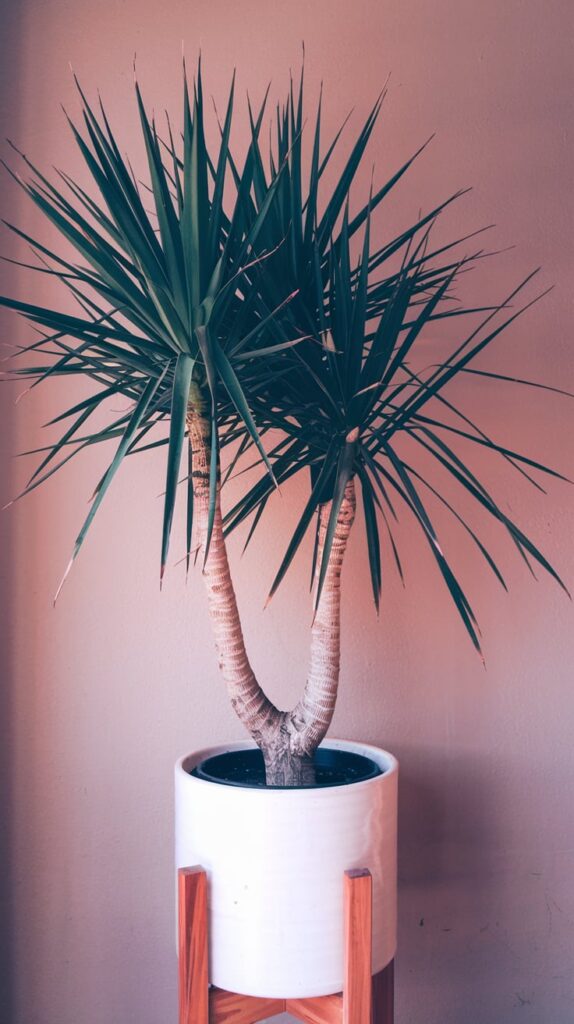
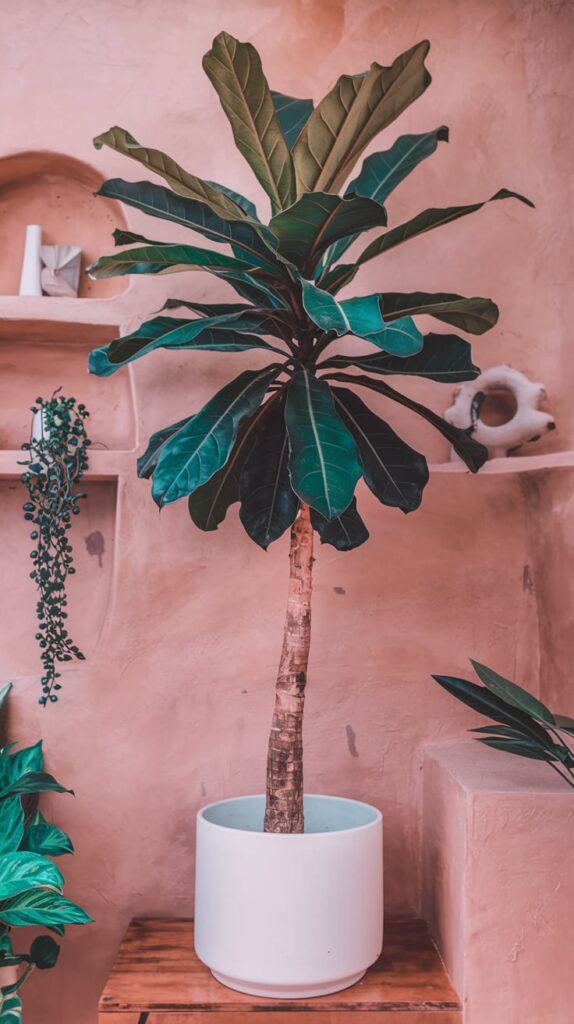
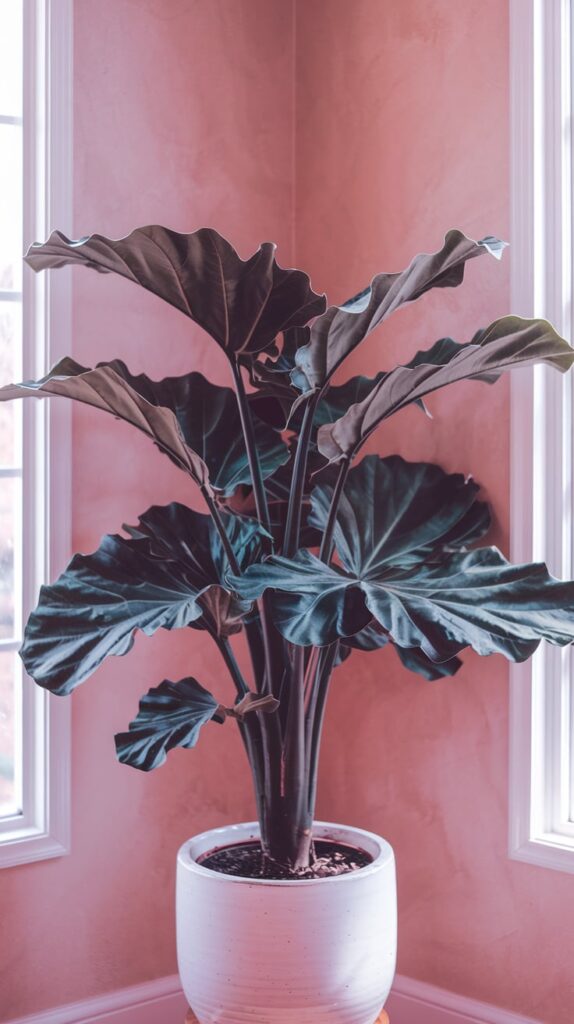
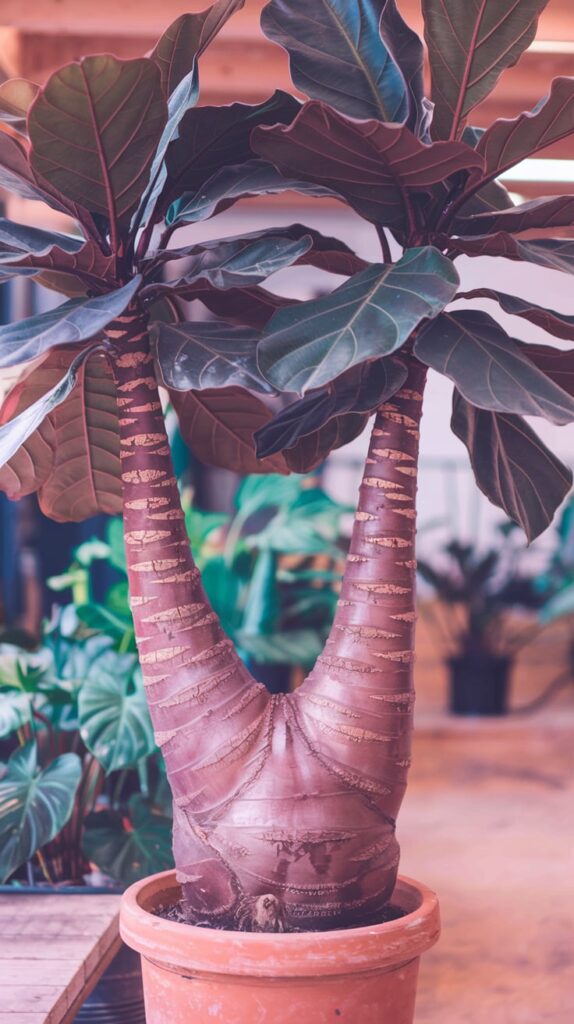
Styling Tips for Large Indoor Plants
Choosing the Right Pot
Selecting Complementary Pots: The pot you choose can enhance the beauty of your large indoor plants. Opt for pots that match your decor style—whether sleek and modern, rustic and earthy, or bold and colorful. A neutral-toned ceramic pot can provide an elegant base for a tall plant like the Fiddle Leaf Fig, while woven baskets offer a boho-chic vibe for the Majesty Palm.
Importance of Drainage and Pot Size: Ensure the pot has adequate drainage to prevent water buildup at the roots. The pot size is also crucial—select a pot that allows room for root expansion without being too large, as this can lead to overwatering.
Placement Ideas
Creative Placement Ideas: Large indoor plants can fit seamlessly into various areas of your home. Place a tall plant like the Bird of Paradise in an empty corner to fill vertical space, or use a Rubber Plant next to your sofa to soften harsh lines in the room. For a layered look, place smaller plants on stands or shelves next to your large indoor plants.
Ideas for Different Rooms:
- Living room: Use plants as statement pieces or to soften furniture.
- Bedroom: Add tranquility with a large plant by the window.
- Bathroom: Choose plants that thrive in humidity, like the Monstera Deliciosa.
Combining with Other Decor Elements
Pairing with Furniture and Accessories: When styling large indoor plants, think about how they interact with the rest of your decor. Pair them with natural materials like wood or stone to create an organic feel. Plants like the Rubber Plant or Majesty Palm can balance bold, minimalist furniture with their soft, textured leaves.
Creating Stylish Plant Displays: Group multiple plants together for a dynamic display, mixing plants of different heights and leaf shapes for visual interest. Use plant stands or shelves to create varying levels, adding dimension to your room. Complement your plant arrangement with woven rugs, wall art, or light fixtures for a cohesive look.
Conclusion
Caring for and styling large indoor plants doesn’t have to be daunting. By understanding their light, water, soil, and maintenance needs, you can ensure that your plants thrive in your home. Additionally, integrating these plants into your decor adds an aesthetic and natural touch, transforming any room into a beautiful, inviting space. With the right care and creativity, your large indoor plants will not only improve your living environment but also become stunning focal points in your home.
